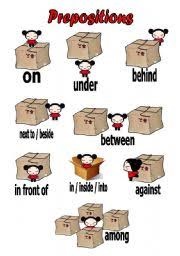|
|
| |
|
|
| |
|
|
|
|
| |
 |
| A few examples of
prepositions. |
Prepositions
Prepositions are words which link nouns, pronouns and
phrases to other words in a sentence.
Prepositions often describe the position of something,
the time when something happens or the way in which
something is done. The prepositions "of", "to" and "for"
have other functions.
In general, because they are links, prepositions belong
in the middle of sentences. Putting a preposition at the
end of a sentence is incorrect.
Example 1: "What did you put that there for?" (better
English is the alternative: "Why did you put that
there?")
Example 2: "A pen is a device to write with" (better
English is "A pen is a writing device"). |
|
|
The table below shows some examples of how prepositions
are used in sentences. |
|
|
|
Function
|
Sentence
|
|
Position
|
The cat is under the table.
He is sitting on the chair.
The pencil is in the box.
|
|
Time
|
The class starts at 8
am.
I am going to
Spain on Wednesday.
|
|
How something is done
|
We traveled by car.
|
|
Possession
|
The book belongs to Colin.
The door of the house is red.
|
|
|
Compound prepositions
Compound prepositions come in two forms; two-word
prepositions and three-word prepositions.
Some examples of two-word prepositions are: |
- According to
- Because of
- Due to
- Instead of
|
|
Some examples of three-word compound prepositions are: |
- As far as
- In addition to
- In front of
- In spite of
|
|
It's always a good idea to try and find the simplest way of
writing something. Using compound prepositions in sentences
should be used rarely. For example, it's much better to use
the word like than say in a manner similar to. |
|
|
|
|
|
|
|
|
|
|
|
|
|
|
|
|
|
|
Search Fun Easy English |
|
|
|
|
|
|
|
|
|
|
|
|
|
|
|
About
Contact
Copyright
Resources
Site Map |